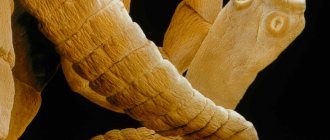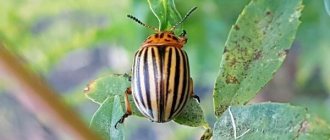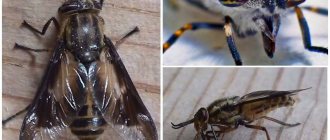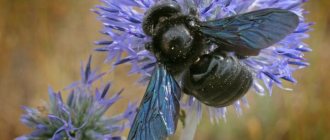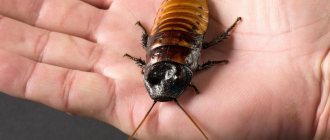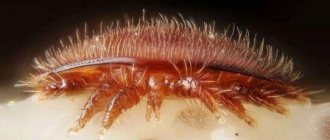Description of the insect
Surprisingly, about 5 thousand species of these bugs live throughout the globe . True, in the European part there are only 100. Insects love warmth, so they are active only in warm weather, and when it is cold, they fly less and do it much more slowly.
There is an opinion that the number of black dots on the body of a ladybug indicates the age of the insect - this is not so. Rather, from these points you can understand what species the bug belongs to.
A ladybug can be more than just red or orange. The ten-spotted ladybug has a dark brown color, the fourteen-spotted ladybird is yellow, the dotted ladybird is completely black, and the streaked ladybird is black with a yellow speck. There are representatives of the species that are very easy to confuse with other beetles. Moreover, not all of them are smooth; there are even very furry species of insects, which is unusual for us.
If you touch a ladybug, it will secrete a yellow substance with an unpleasant odor - this is a defensive moment that allows you to scare away creatures that are dangerous to the insect.
Structural features
The sizes of these insects vary from four to ten millimeters. They have an elongated oval or round body with a strongly convex back. For those who do not know how ladybugs reproduce, it will be interesting that the surface of some species of these insects is covered with fine hairs.
The body of the beetles consists of a small head, pronotum, thorax, abdomen and wings with elytra. In addition, each individual has three pairs of legs. They use cantharidin as protection against predators. This poisonous, unpleasant-smelling yellow liquid repels birds and other potential enemies from insects.
Depending on the type of insect, its elytra can be brown, dark blue, black, bright yellow or deep red. Some of them have spots of different shades and configurations. Others have no patterns at all. And the seven-spotted ladybug is so named because it has seven spots on its back.
Insect nutrition
The main feature of the ladybug for every summer resident is her love for aphids. More precisely, eating this pest. Interestingly, in search of its favorite food, an insect can cover a considerable distance. Adults of these nimble bugs can eat up to 150 aphids per day.
Some species include the following types of insects in their diet:
- whiteflies;
- scale insects;
- spider mites;
- Mealybugs.
There are even several species that eat fungal spores. Insects also love plant pollen and flower nectar.
The type of relationship between these creatures
The ladybug and aphid relationship is one of predator and prey. Their relationship begins at the ladybird larval stage. When it is finally formed, it eats up to two hundred aphid insects per day from spring to autumn.
After the bugs are saturated with pollen and aphids, eggs are laid not far from the insect colony. The hatched ladybird larvae, not finding aphids nearby, can easily eat neighboring eggs in order to accumulate nutrients. But their favorite delicacy is still aphids; about 1000 of these insects are needed to develop one larva.
Life cycle of an insect
After fertilization, the adult female lays dark yellow oblong eggs. She tries to attach them to different parts of the plant, closer to the food source - and this is, for example, the same aphid. During its entire short life, which does not last more than a year and a half, the cow manages to lay more than 1000 eggs. These then hatch into larvae, which in turn turn into pupae, which then become an adult.
The period during which an adult beetle emerges from a laid egg reaches 40-60 days (in our climatic conditions).
As autumn approaches, ladybugs look for shelter where they can safely spend the winter. This could be stones, tree bark, piles of leaves or pine needles. Often the bug chooses a window crack or window sill as a place for wintering. But there they almost never manage to wait for spring; they dry up.
Insects in winter
As already mentioned, they can winter in the place where they spend the summer, burying themselves in fallen leaves or hiding under the bark of trees. They can be found anywhere on earth except Antarctica.
They prefer green meadows, fragrant plants near water bodies, and green gardens. There are those who prefer to fly during the cold winter. They gather in groups and fly long distances, all in order to provide themselves with food.
The flights are made quite high and it will be very difficult for a person to notice them. Strong gusts of wind can become a strong obstacle on the way; they are forced to interrupt the flight and wait for favorable weather.
Ladybug. Benefits and harms (video)
- The melon ladybug, for example, damages melon crops. It is common in Africa, Asia and some European countries. In Turkmenistan, this species causes serious damage to the crop; in our latitudes, this insect species is absent.
- The 28-spotted ladybug causes serious damage to crops in the Far East (Amur Region, southern Sakhalin, Primorsky Territory, Khabarovsk Territory, South Kuril Islands). Otherwise, this insect is called the potato ladybug, but it loves to eat not only everyone’s favorite vegetable crop, but also cucumbers, watermelons and tomatoes. The harm it causes is considerable, because on its wings it also carries dangerous viruses.
Benefits of insects
The most important advantage of this bug is that it eats pests. This means that the plants on the site are less exposed to the negative effects of parasites.
- Aphids are the brightly colored bug's favorite food. This pest feeds on plant juices, and aphids also transmit viral diseases (so the harm of these parasites is not exaggerated). You may also be interested in an article that talks about how you can get rid of aphids and why they are dangerous.
- with mealybugs, mites and scale insects ; the damage from them to the crop only increases, but nothing “takes them”, and sometimes only a ladybug can help.
Therefore, it is possible and necessary to attract insects to your site, because there are significantly fewer harmful species than beneficial ones.
How to attract a beneficial bug to the garden
It is impossible to say exactly where the insect will want to settle. But in order for it to end up on your site and help you cope with parasites that harm vegetation, you need to try to make your garden attractive to this bug. And this means:
- limit chemical means of protection on the site or choose those whose use causes minimal harm to the insect;
- leave a small space on the site that does not need to be touched (mow and rake grass, leaves);
- in the city you can plant angelica and dill;
- leave dandelions and yarrows in some places on the site;
- Buckwheat, tansy and legumes are among those plants that may tempt a ladybug.
Additional measures
- To ensure that flowering plants attract the ladybug throughout the season, you need to start by planting those that bloom earlier. That is, you can plant buckwheat first, then dill, etc.
- It is believed that the goal of attracting a brightly colored beetle to your site is not to completely exterminate aphids, but to control the population of this pest.
- There is such a thing as artificial food - this is a dry powder that you can buy, spray it on an area, and feed the insects. If there is not enough natural food for ladybugs, they may leave the area, so sometimes you have to resort to such measures.
- And some gardeners actively use baits that are designed to attract bees.
Stages of ladybug development. presentation for a lesson on the world around us (grade 4) on the topic
Slide 1
Stages of development of a ladybug The work was carried out by a student of grade 4 "a" of secondary school No. 9 Rychkov Egor Project manager Stepanova T.V.
Slide 2
Ladybug is a family of beetles called coccinellids in Latin.
Slide 3
The development of an insect with complete transformation is characterized by the passage of four to five stages: *eggs, *larvae, *pupae, *imago, *prepupae
Slide 4
Ladybug clutch. In nature, the ladybug leaves clutches on the underside of the leaf. The eggs in the clutch are yellow and oval in shape. Seeing it, many take it for a plant disease and fight the affected leaves, destroying future beneficial insects, THE MOST IMPORTANT PROTECTORS of the crop!
Slide 5
Larvae on the first birthday The appearance of ladybug larvae on the third day after laying eggs! This is a very rapid ripening, which is associated with elevated temperatures. At night and in cold weather, insects are immobilized, but in a warm, favorable state, activity increases.
Slide 6
ONE DAY OF LIFE and the first molt! One day and one night on a home farm accelerated development three times faster than in a natural habitat. The first moult on the second day of life from the moment of birth is a record short time. Having shed the skin of a newborn larva, the baby has grown noticeably and acquired tubercles and tiny spots on its back.
Slide 7
On the third day. In the larval stage of development, ladybug babies are constantly on the move, searching for food. An interesting fact is that insects do not see aphids, but stumble upon colonies of pests, gradually exploring one plant and moving on to another. The glutton larvae are active all day long, and on the third day they molt again and become half a centimeter long, which is five times longer than at the time of birth! On the seventh day of life, after another molt, the chubby gluttons grew to one and a half centimeters in length, and the next day, having greatly increased in volume, they began to pupate.
Slide 8
Ladybug larvae are the SECOND LIFE of insects! The most dangerous and active period of an insect’s life is in the larval stage of development. The absence of wings does not make it possible to escape from enemies; one has to rely on fast legs and camouflage coloring, and travel quite long distances in search of food. So the ability to hide will also come in handy. A difficult and dangerous period is accompanied by external changes in the larvae; during this time they molt several times. As a result, they grow twice as large as a real beetle.
Slide 9
Be careful! These are ladybird larvae. You won't immediately recognize the beetle in this appearance, but the red spots on the sides should attract attention. DO NOT CONFUSE these predators with PESTS! THESE ARE CROP DEFENDERS, an army of liquidators of aphids, psyllids, scale insects and mites. It also destroys the larvae of the Colorado potato beetle and other garden pests. During its life, one ladybug eats several thousand aphids.
Slide 10
LADYBUG PUPPE - THIRD LIFE! The ladybug pupa already resembles a real beetle in size and color! Having attached itself to the plants with its tail part, the insect larva is completely transformed. It does not die, it is quite alive, albeit motionless, but still active, a very complex internal life cycle of development!
Slide 11
Ladybug pupa. The very beginning of birth. The first minutes of birth.
Slide 12
To dry its wings, the insect sits motionless for a long time, gradually straightening them, and then, carefully folding them into a little bag, putting them away.
Slide 13
The imago is an adult insect; within an hour, newborn yellow insects will develop spots on their soft, translucent wings; as the elytra dry out, they will become hard and turn red. And the next day, the stronger babies will be able to fly, but they will no longer grow, and the points will not increase over the years. The red seven-spotted ladybug changes color from yellow to red in the first hours after its appearance, spots appear, ALL seven spots at once!
Slide 14
Types of ladybug Two-spotted Five-spotted Seven-spotted
Slide 15
Eleven-point Twelve-point
Slide 16
Different names in different countries Germany, Austria, Switzerland - St. Mary's beetle. England, USA, Australia, South Africa - Lady Bug. Argentina - St. Anthony's cow. The Czech Republic, Slovakia, Ukraine and Belarus are rays of sunshine. Tajikistan - Red-bearded grandfather.
Slide 17
Sources used Brockhaus F.A., Efron I.A. Encyclopedic Dictionary sne-gurka-2.narod.ru www.zagadaika.ru


